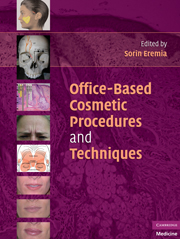Book contents
- Frontmatter
- Contents
- PREFACE
- CONTRIBUTORS
- PART ONE ANATOMY AND THE AGING PROCESS
- PART TWO ANESTHESIA AND SEDATION FOR OFFICE COSMETIC PROCEDURES
- PART THREE FILLERS AND NEUROTOXINS
- PART FOUR COSMETIC APPLICATIONS OF LIGHT, RADIOFREQUENCY, AND ULTRASOUND ENERGY
- PART FIVE OTHER PROCEDURES
- Chap. 72 SUTURE SUSPENSION LIFTS: AN OVERVIEW
- Chap. 73 SILHOUETTE SUTURES
- Chap. 74 CHEMICAL PEELS AND MICRODERMABRASION
- Chap. 75 PEELING TECHNIQUES FROM EUROPE
- Chap. 76 MESOTHERAPY: INJECTION LIPOLYSIS
- INDEX
- References
Chap. 76 - MESOTHERAPY: INJECTION LIPOLYSIS
from PART FIVE - OTHER PROCEDURES
Published online by Cambridge University Press: 06 July 2010
- Frontmatter
- Contents
- PREFACE
- CONTRIBUTORS
- PART ONE ANATOMY AND THE AGING PROCESS
- PART TWO ANESTHESIA AND SEDATION FOR OFFICE COSMETIC PROCEDURES
- PART THREE FILLERS AND NEUROTOXINS
- PART FOUR COSMETIC APPLICATIONS OF LIGHT, RADIOFREQUENCY, AND ULTRASOUND ENERGY
- PART FIVE OTHER PROCEDURES
- Chap. 72 SUTURE SUSPENSION LIFTS: AN OVERVIEW
- Chap. 73 SILHOUETTE SUTURES
- Chap. 74 CHEMICAL PEELS AND MICRODERMABRASION
- Chap. 75 PEELING TECHNIQUES FROM EUROPE
- Chap. 76 MESOTHERAPY: INJECTION LIPOLYSIS
- INDEX
- References
Summary
The term injection lipolysis, which is most popularly ascribed, suggests injectable methods which “activate” adipocytes to mobilize their fatty acid stores without affecting the integrity of their cell membranes. The focus of this chapter and indeed the preponderance of literature on the subject of injectable treatments for fat relate to agents that completely ablate or destroy fat by breaking down or solubilizing the fat cell membrane. Adipolytic therapy is therefore a technique that describes the subcutaneous injection of pharmacologically active detergents to chemically ablate localized adipose tissue. In addition to injection lipolysis, numerous names have been ascribed to the technique, including mesotherapy, Lipodissolve®, and mesolipolysis. It has therefore been proposed that the terms injection adipolysis or adipolytic therapy most accurately describe injectable methods that employ detergents to reduce fat. The most well studied component of these treatments is sodium deoxycholate (DC), a biologic detergent. Unless noted elsewhere, this compound is present in all formulations that include phosphatidylcholine (PC)
To date, no European or United States regulatory body has approved a pharmaceutical grade, subcutaneously injected preparation indicated to treat fat. As such, there are neither standardized practices, nor formal teaching of the technique in post-graduate residency training programs. Therefore, physicians worldwide have been teaching one another through continuing education conferences or peer-reviewed publications. In the US, the most commonly used agents, phosphatidylcholine (PC) and deoxycholate (DC), are typically obtained from compounding pharmacies. In Europe, Lipostabil®, Sanofi-Aventis, is commonly used.
- Type
- Chapter
- Information
- Office-Based Cosmetic Procedures and Techniques , pp. 349 - 356Publisher: Cambridge University PressPrint publication year: 2010

